Teak Countertops (Design Types & Pros and Cons)
This gallery of teak countertops shares what they are, their pros and cons, durability, different types, price, cleaning tips, and countertop kitchen designs.
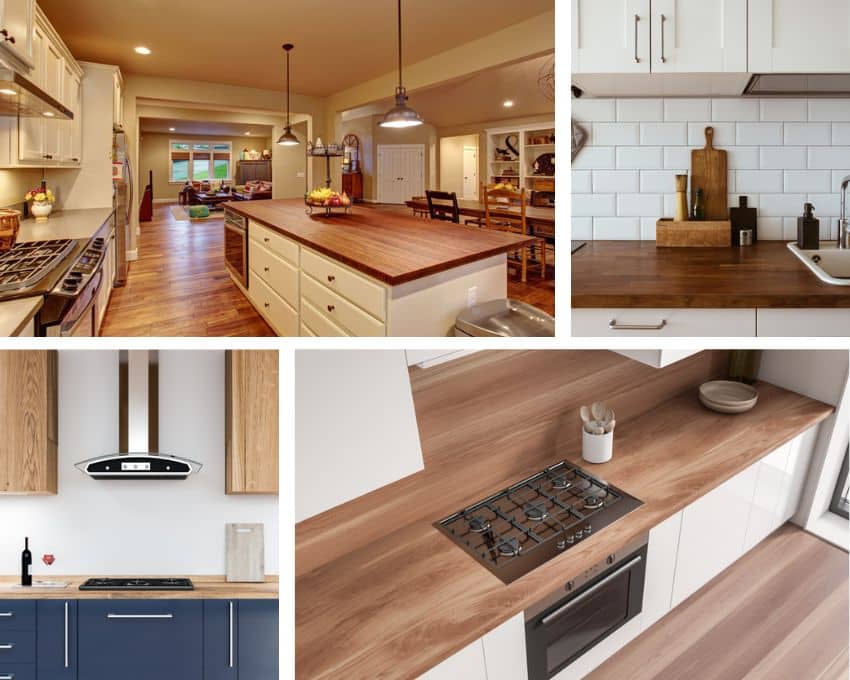
Teak is a medium-density hardwood that is both durable and long-lasting. It has all of the attributes you are looking for in a countertop. Moreover, it’s a popular choice for many sorts of furniture since it is both versatile and waterproof.
With its rich, warm tones, it is also largely regarded as one of the most exquisite woods in the world. Read this article to find out if this is a suitable wood to use when building a countertop or for a room renovation project.
Quicklook: Types Of Teak Countertops
• Butcher Block
• Burmese
• Brazilian
• African Plantation
• Indian
• Edge Grain
• End Grain
What Are Teak Wood Countertops?
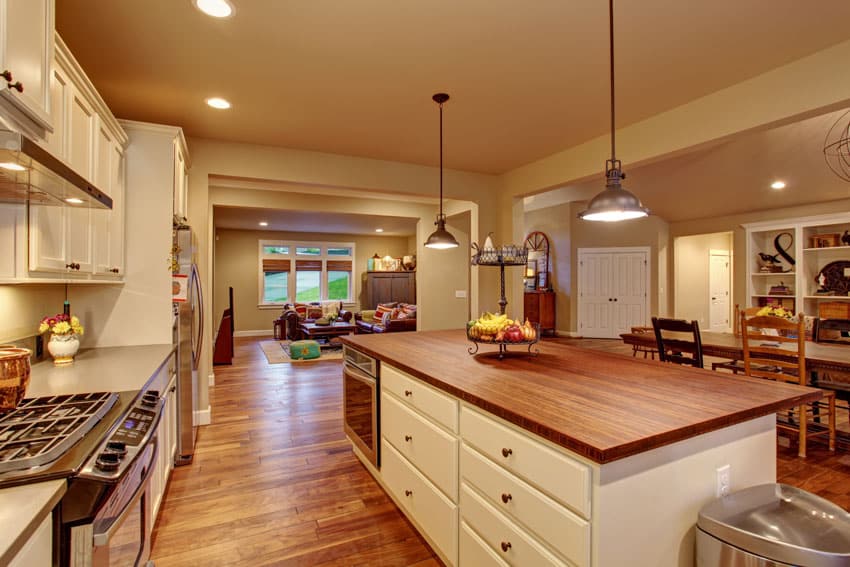
Even before the advent of antiquity, wood has always been the ideal material for furniture construction. These countertops make an impression with their visual beauty, warm touch, and distinctive natural hue.
Typical wooden countertops have the inclination to weaken knife blades. Teak countertops, on the other hand, are gentle on knife blades. Thus, you will not have to change the knife that frequently. You can cut, chop, mince, and dice for so many years without bothering about knife blades becoming blunt.
Teak carves nicely and is quite durable, possessing an oily component which repels insect pests. – Sculpture in Wood, Jack C. Rich
Moreover, solid wood of this variety supplied from agricultural farmlands, which is legally permitted for use in countertops and other furniture manufacturing as well as other industries, is an excellent way to protect the natural environment.
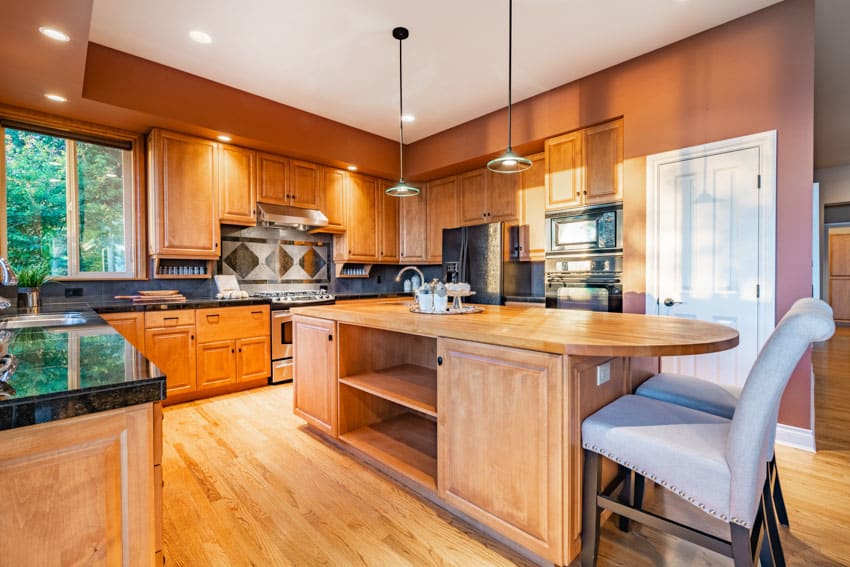
These counters are a hygienic option because the natural oils in teak keep the exterior layer germ-free. Even if microorganisms get into the pores, the oil in the solid wood absorbs and destroys them. Hence, the wood is arguably the most ideal wood material for kitchen countertops.
Teak Countertops Pros And Cons
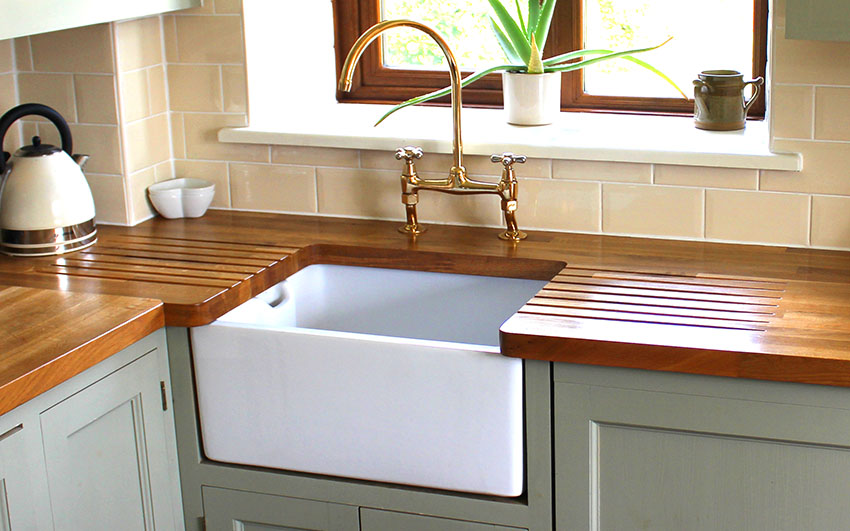
Pros Of Teak Countertops
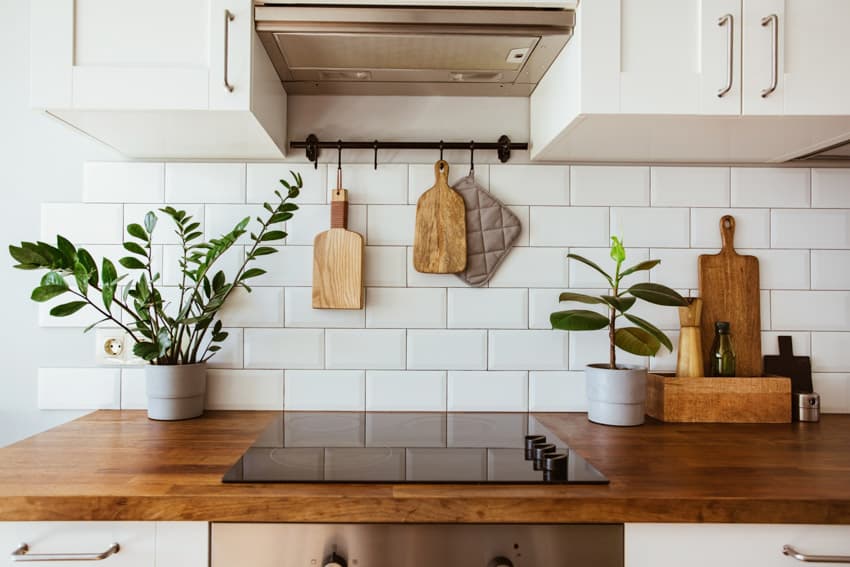
This heavy-duty hardwood is unaffected by exposure to the ocean’s water, as well as the sun and wind. Therefore, these wood countertops can last for generations if properly cared for. This variety will not get splintered, warped, bent, or cracked under pressure, and it is not affected by continuous water contact.
Furthermore, one of its outstanding characteristics is its longevity. It is among the hardest wood products and can survive for decades even if left untreated.
As a result, if you choose it as a countertop, you will be investing in a masterpiece that will endure the entirety of your life and can afterward be handed down to your kids one day. It really is that tough and enduring even if you do not use sealants or waxes on it.
Untreated countertops do not affect their lifespan or strength. Nonetheless, this does not prohibit you from treating your wood. You can certainly apply sheens and sealants to the wood; the option is yours.
Woodworking- and Carving-Friendly: The wood is ideal for carving because of its medium-density structure (650 kg/m3). It is a fairly adequate and easy-to-handle density average. High-density hardwoods are more likely to be decorated.
Because of its clean and straight grain, woodworkers who create countertops love working with it. It does not chip or fracture, which adds to its longevity and makes delicate patterns easier to carve out. The wood accepts screws and nails smoothly, making it perfect for construction purposes. When sanding, milling, or planing the wood, no difficulties or complications will develop.
You might choose to keep your wood countertop in its natural condition. You can paint, stain, polish, wax, or varnish the wood if you choose.
In terms of treating, sticking to your preferred treatment method is not an issue. This versatile wood comes with customization possibilities and can generate a variety of appearances using different techniques.
Has Very High Resistance Against Bacteria, Fungi, Woodworms, and Termites: The trees are safeguarded by silicon as well as tannins that are naturally present in their composition. Because trees, unlike other living things, cannot move, they were required to establish a natural defense against infections such as fungi, viruses, and bacteria. Tannins are these protecting elements.
In addition, it’s fully saturated in a variety of protective wood oils. These oils work as natural disinfectants, making it a healthy countertop option. These disinfecting oils and their distinct chemical structure hinder the growth of germs and mold, effectively preventing woodworms from devouring them.
Teak is particularly resistant to mildew and decay due to the natural oils it contains. Termites learn that attacking a this tree is not worth the trouble. The oils work as a repellent to termites, reducing the likelihood of these pests ruining your countertop.
Extremely Water-Resistant: These wood countertops will not enable moisture to permeate or cause harm even when exposed to prolonged water exposure. It can endure water or fluid spills and is simple to maintain as a countertop. When continually subjected to water, your countertop will never deform, break, or expand.
Unlike many other types of wood, you will not need to anticipate a wet, rotten black circle around your water basin. Furthermore, this wood has a significant oil content as aforementioned, which makes it waterproof and defends it from water deterioration as well as the sun’s damaging UV rays.
Fire-Resistant and Has Good Insulating Properties: Although wood varnish is renowned to burn rapidly, teak wood will not, owing to its oil composition, henceforth it is extremely fire-retardant. This variety is a leader when it pertains to heat absorption.
Briefly expressed, the wood will not feel extremely hot when touched during the summertime but will keep the warmth throughout the harsh winter months. This is among the motivating factors why it is popular for outdoor countertops.
Pleasing-to-the-Eye Appearance: Countertops are very eye-pleasing. The heartwood typically features a golden brown yellow, honey tint, or a deep brown with rich brown patterns.
The wood is also known for its golden luster. Its sapwood, on the other hand, varies in hue from gray to white and light yellowish-brown. When subjected to the weather, it takes on a warm golden-brown hue.
These countertops often turn dark brown when untreated and subjected to the environment. When left in the sun for extended durations, it will develop a silver-gray hue or undertones, which is still visually appealing.
Cons Of Teak Countertops
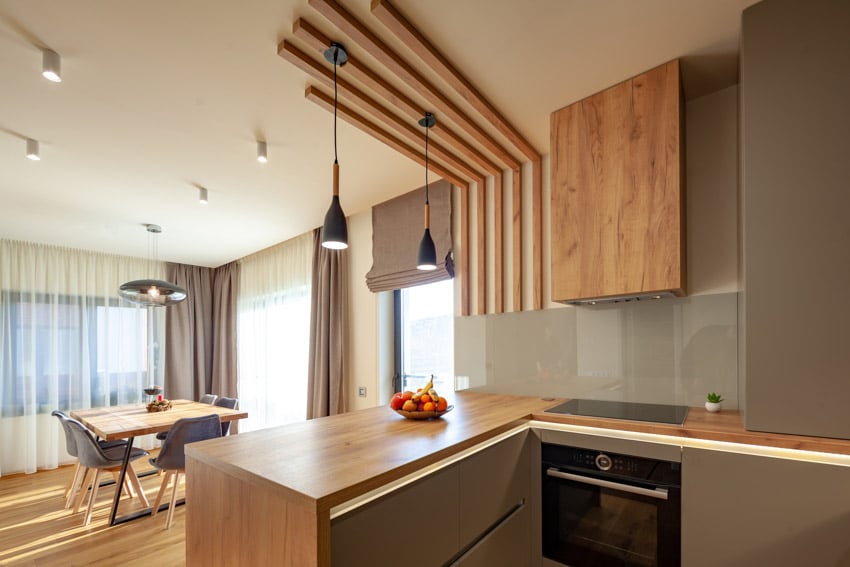
In comparison to the cost, you might notice that other woods will be significantly less expensive. Teak is a superior wood, and it will cost you higher than other inferior wood varieties.
Not Widely Available: The primary reason for the premium price is that its availability is lower than its demand, which increases the cost due to rarity.
This well-known wood has been listed as an endangered species, and certain authorities have imposed limits on how much can be taken and sold. This issue will make it difficult to find genuine types, and it will be expensive.
Teak Wood Hardness (Janka Rating)
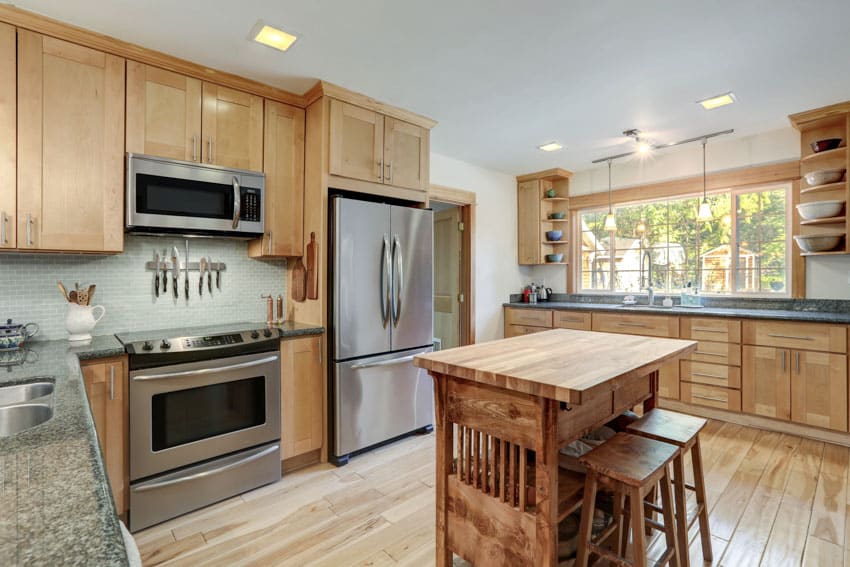
Since it shares the same structural strength and density as heartwood, it is easier to employ without incurring durability issues.
Types Of Teak Kitchen Countertops
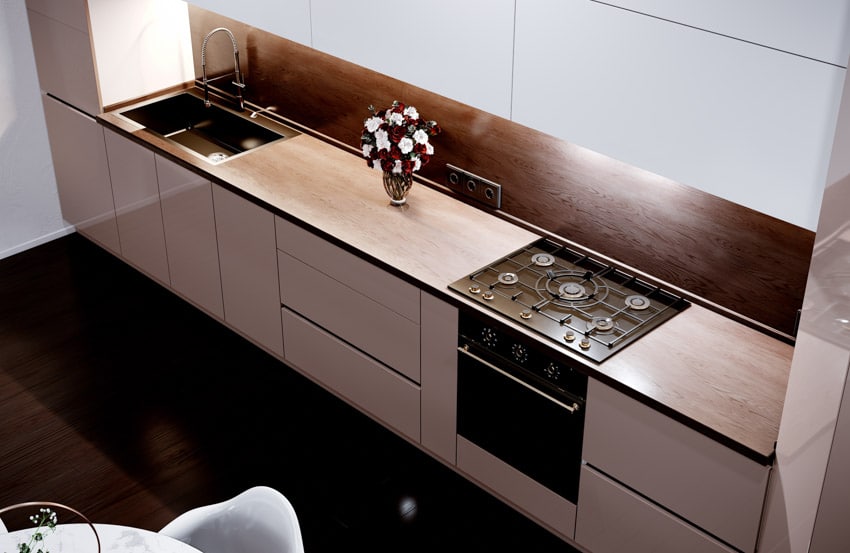
Teak Butcher Block Countertops
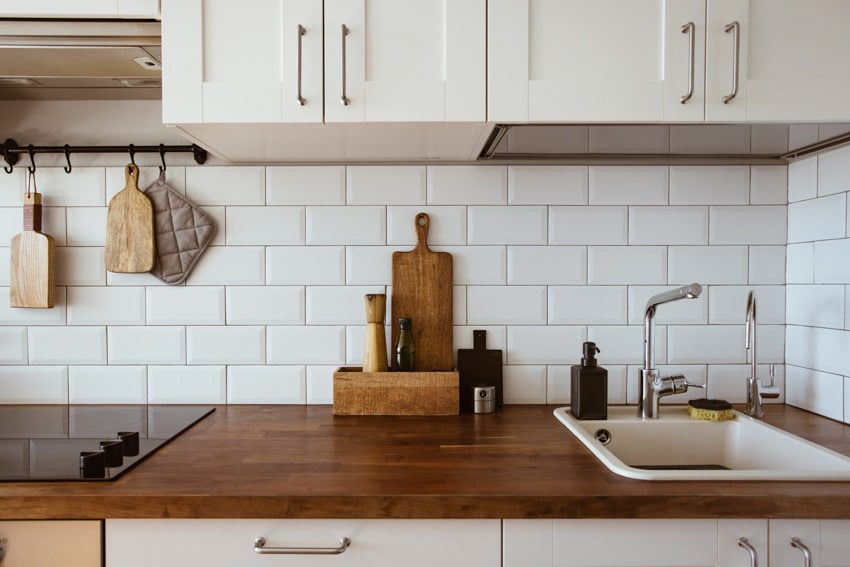
Butcher block countertops made of this material have been popular for generations. This hardwood renders the block robust enough to withstand cutting impacts.
Even the wood’s long-lasting quality makes it excellent for breaking multiple items or cutting food while remaining durable for years.
Burmese Teak Countertops
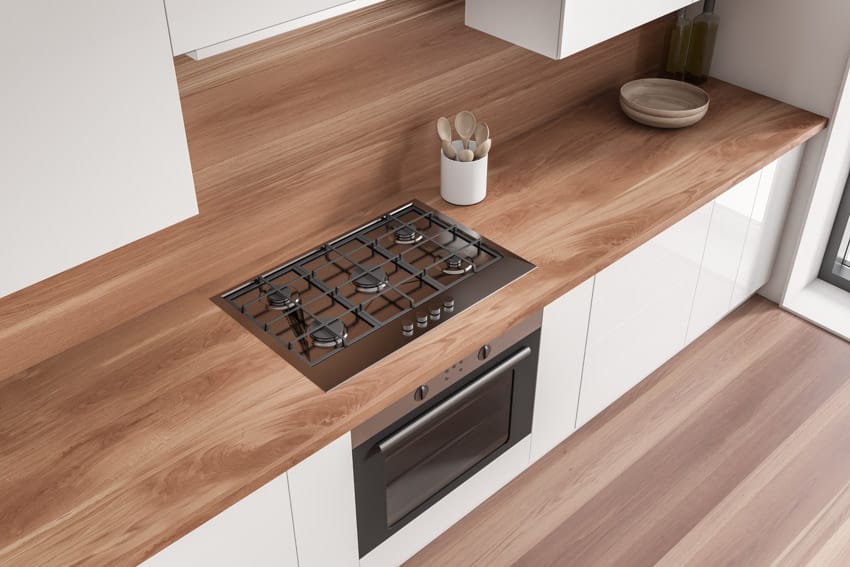
It is the highest-quality wood type currently available. It features a golden tint, finely scattered grains, as well as a high concentration of natural oils. It is the most long-lasting variety.
The heartwood is typically golden to light brown, becoming richer as the wood matures. It will either have plain or wavy types of wood grain patterns. It has a gritty texture and a natural shine. Burmese variety is typically utilized for countertops that see a lot of activity.
Brazilian Teak Countertops
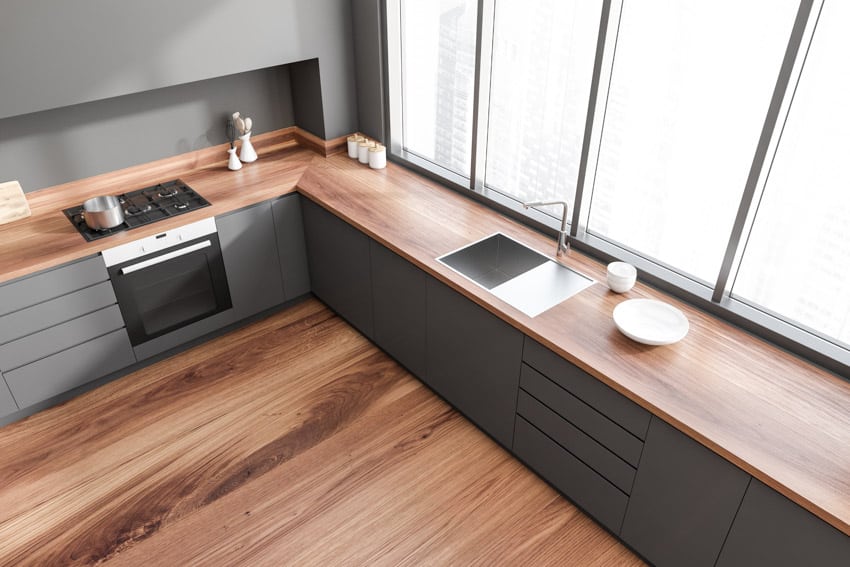
It is extremely hard, sturdy, waterproof, and long-lasting. It contains a high concentration of natural oils, which render it moisture-resistant and impervious to parasites and insects.
The grain distribution is considerably different from that of genuine Burmese teak wood. Brazilian wood is reddish-brown rather than golden brown.
African Plantation Teak Countertop
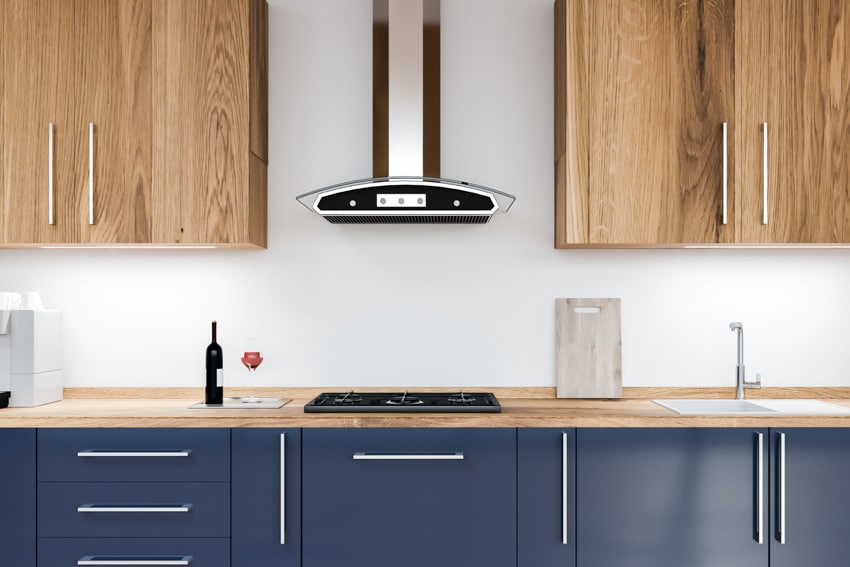
As a result, African plantation wood is not quite as strong as Burmese wood. It is a pretty light brown color. The wood grains are significantly apart. There are several sound knots in it as well.
Indian Teak Countertop

This wood is precious since the trees have the potential to mature into old-growth teak. This implies that the wood will have a lovely color, rich and full of valuable oils, and will make top-quality countertops.
Edge Grain Teak Countertop
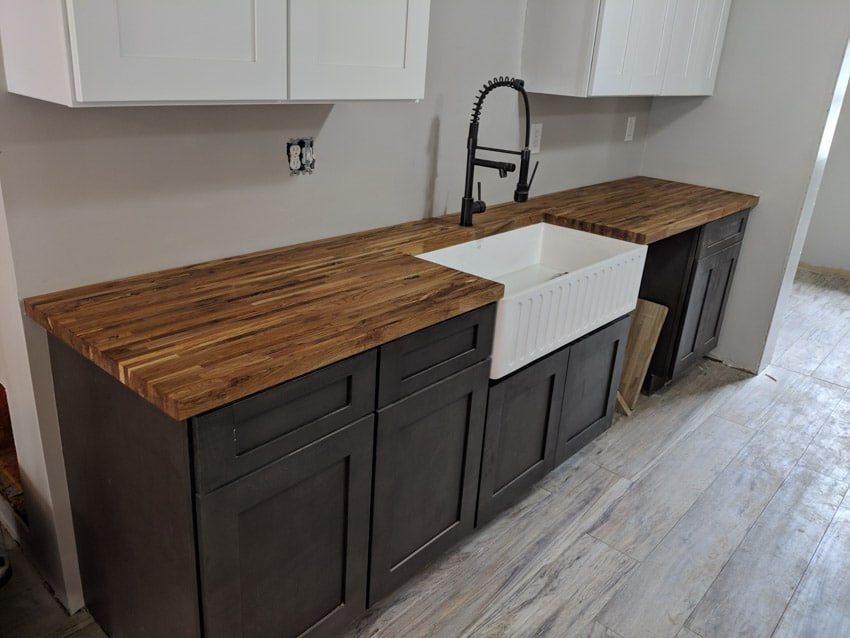
Teak countertops with edge grain are easy on blades and resist scratches and warping, preserving their aesthetic even after years of heavy usage.
A live edge countertop has wood on the leading edge that has a natural appearance that looks like a tree with all of its character and imperfections. This simply means that the wood has not been cut straight on the side. These can make impressive breakfast bars and dining tables and their eye-catching style is a real conversation starter.
End Grain Teak Countertop

End grain countertops have a noticeable golden brown heartwood that darkens with weathering, whereas the sapwood is cream-toned.
Teak Countertops Price
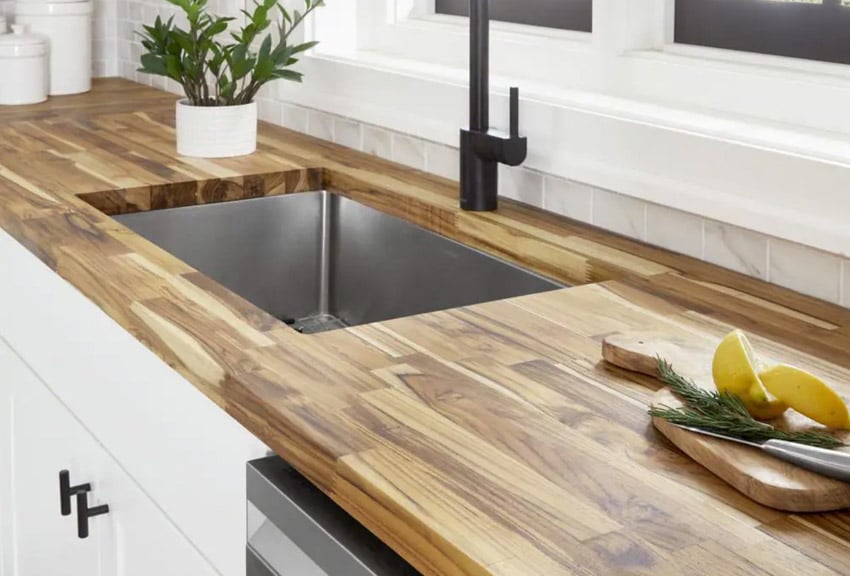
Teak lumber is one of the most expensive types of wood. This style of countertop costs approximately $100 to $300. Most often, it is custom work.
This material has grown in popularity as a luxury wood for anything, from teak kitchen cabinets, countertops to flooring and cladding.
However, as previously stated, due to their scarcity, their cost is normally higher than other typical types of wood used for countertops.
Cleaning Teak Countertops
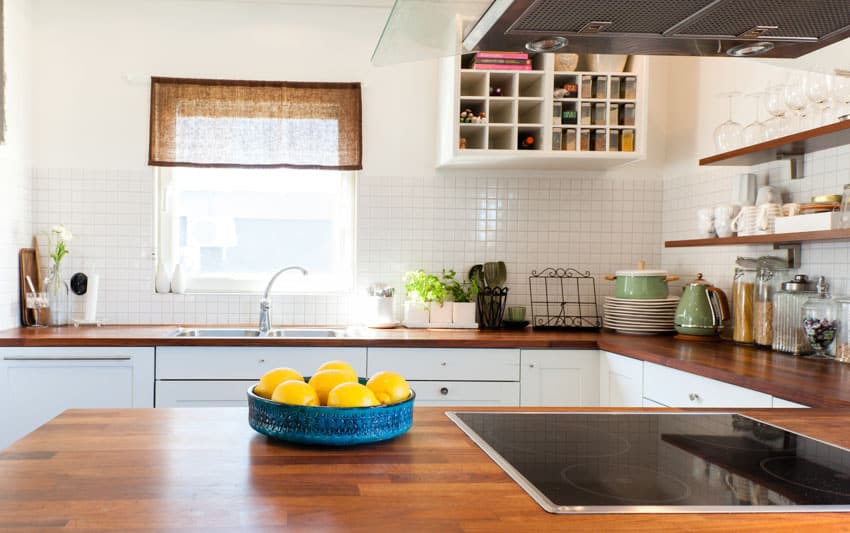
Nonetheless, if not properly maintained, unpleasant mildew can develop on the surface, staining both treated surfaces and naturally aged wood.
Once mildew is visible, scrubbing with a soft nylon scrubbing brush as well as a combination of mild detergent, water, and a little bleach or vinegar will generally solve the problem. Numerous woodworking experts and furniture makers highly advise avoiding using metal brushes since they can harm the wood.
Specialized cleaners can also be purchased to remove tougher stains or deposits. All you have to do to clean the countertop successfully is read and follow the directions included with the cleaner before using it.
The regularity of your countertop cleaning will be determined by the conditions to which it is exposed. The type that is used in high-traffic countertops, for instance, will most likely necessitate more extensive cleaning.
However, you have to take note that whatever your cleaning requirements are, using slightly high-pressure water, metal brushes, or steel wool is not advisable since they will harm the hardwood surface so badly.
Pro Tip: A frequent quick clean with just water and a light scrubbing brush will help prevent stains and fading.
More Tips and Instructions When Cleaning Teak Countertops:
Teak types of kitchen countertops may be cleaned with commercial or homemade cleaning solutions. Aggressive chemical cleansers can practically melt the surface, thus you must start with something gentle.
If you feel you need something a little more powerful, be sure that the chemicals are suitable to be used. If the surface has already been covered with a sealer or varnish, you can use a wood stripper to dissolve it before cleaning.
Three popular and simple DIY cleaning solutions are:
• 1-cup ammonia, 1 cup laundry soap (without bleach) in 1 gallon of warm water
• 1 gallon warm water, 1-cup chlorine bleach, and 1-cup laundry soap
• 1 cup vinegar to 1 gallon of slightly hot water
Whatever solution you pick, you must never mix them, and never, ever combine ammonia and chlorine since this mixture will produce exceedingly poisonous gas.
Distribute the solution to the wood by lightly scrubbing it in with a soft nylon scrubbing brush. Let the cleaning solution sit on the wood for around 15 minutes before carefully rinsing. Cleaning wooden countertops is frequently messy, therefore performing it when there is no food nearby.
Make sure the indoor cleaning space is sufficiently ventilated to protect oneself from possibly toxic fumes. You must ensure that you will open the doors and windows, and consider using a fan. Put on rubber gloves and eye protection when handling chemicals.
Take note: The cleaning combinations listed above are effective on most household wood products such as countertops, especially those that only require minor cleaning.
If your teak has been exposed to elements for an extended duration, or if you reside in a region where the atmosphere is more toxic, you may want a more severe cleaning technique.
Be cautious: most wood cleaners are quite toxic and must only be applied when all other options have been tried. Many of these cleaners can harm the surfaces around them.
See more related content in our article about teak wood flooring on this page.

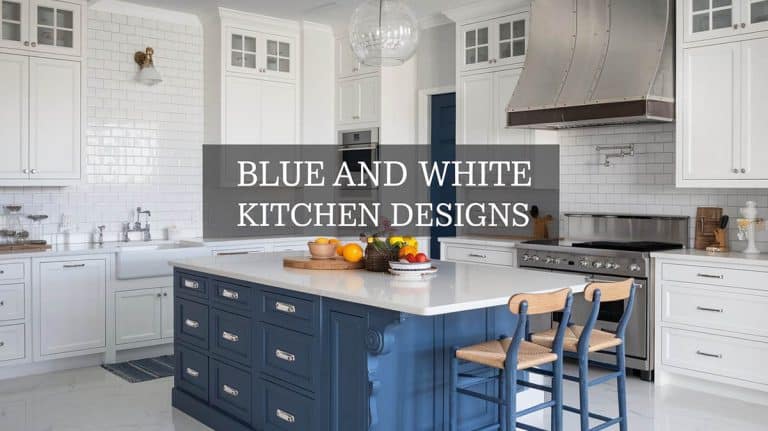
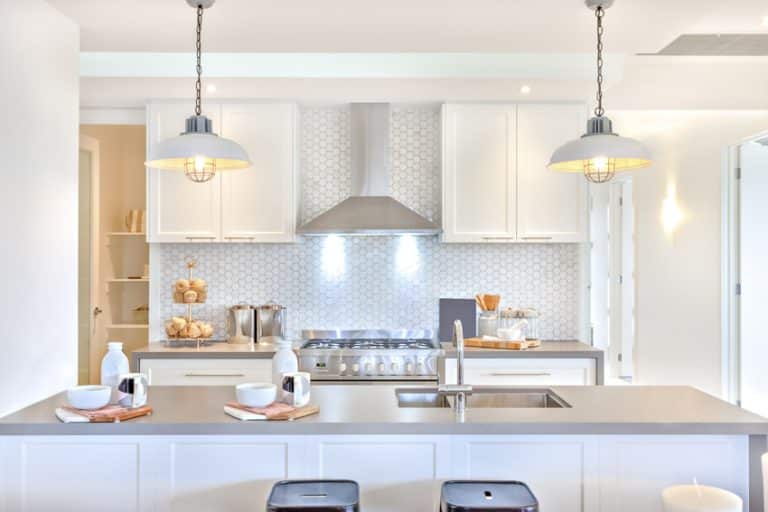
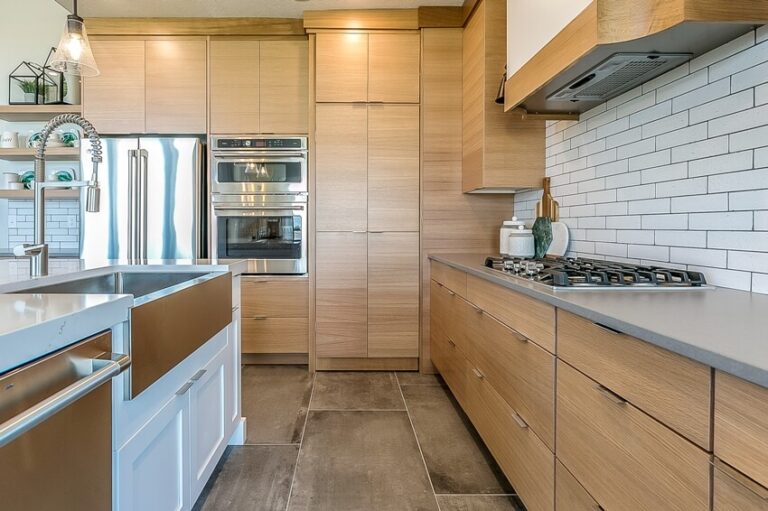
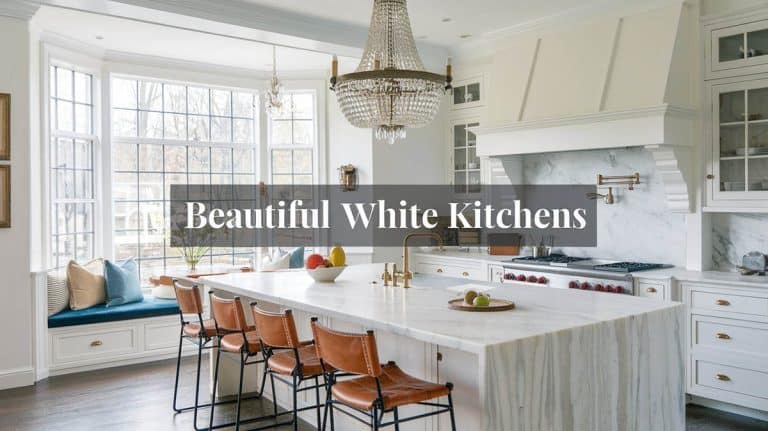
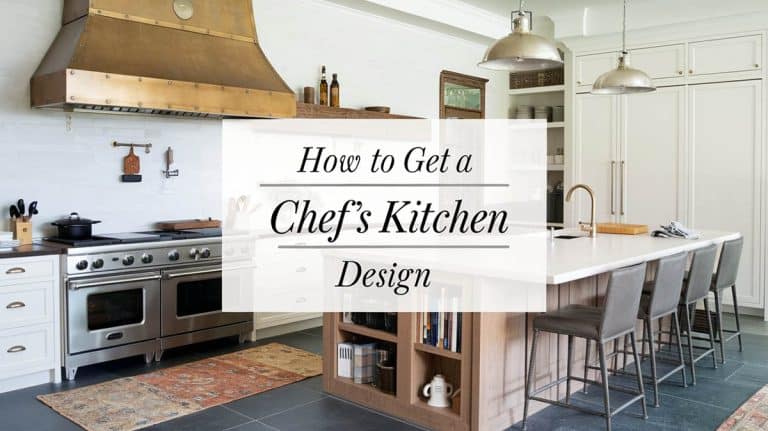
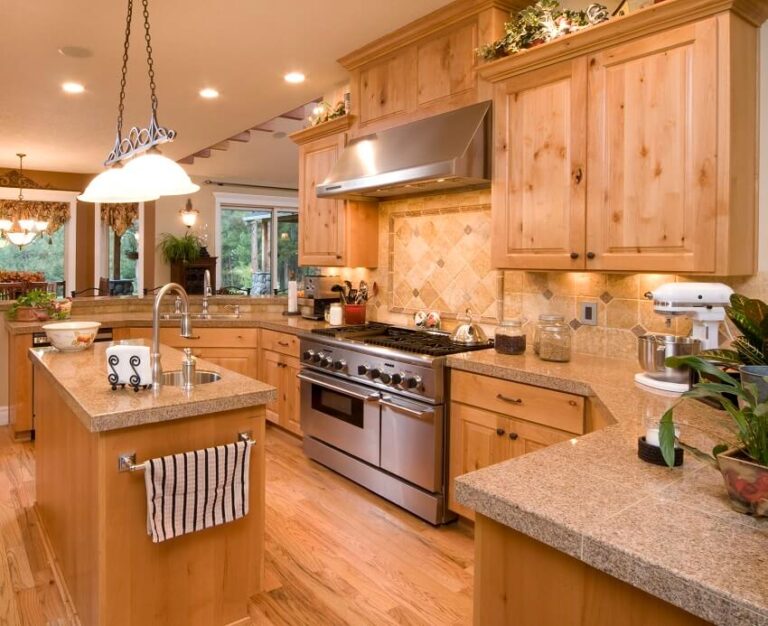
Looking for a teak counter top for a bathroom